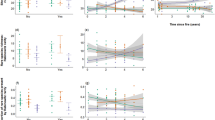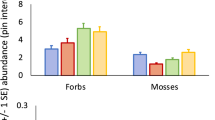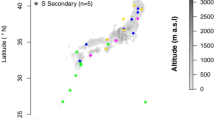Abstract
The fact that temperate grasslands often contain upwards of 30 vascular plant species per m2 yet these species seem to have relatively similar life histories and resource requirements has made explaining species coexistence in these communities a major focus of research. While the reduction of competition by disturbance has been a popular explanation for species coexistence, in tallgrass prairies any level of disturbance either has no effect, or decreases diversity, since it favors the dominant plants. Although there has long been speculation that grassland species could coexist by niche partitioning the concept received renewed interest when it was shown that soil hydrology could explain species coexistence. One aspect of community structure that has not been explained by niche partitioning is the rareness and commonness of species within communities. There are three classes of explanations for rareness: narrow habitat requirements, low competitive ability combined with frequency dependent fitness and, dispersal ability. However, evidence for these explanations tend to be anecdotal, focusing on particular species. Here I show that in tallgrass prairies common and rare species consistently occupy different parts of niche space, with rare species being restricted by the cover of common species and occupying the rare available niches.
Similar content being viewed by others
Introduction
Two of the central questions in ecology are why are there so many species in communities and what role do they play in the functioning of ecosystems. Traditionally, animal communities have been viewed as having many resource niches whereas plants have few due to their similar resource requirements1,2. Plant ecologists have therefore focused attention on processes, such as disturbance, that reduce competitive exclusion by species that share the same niches3,4. However, there has been renewed interest in the concept that plants can show differentiation both in terms of the traits that species posses and their distribution relative to resources and environmental conditions5,6,7. Absent from this analysis is consideration of species abundance within communities. Plant communities, like all other community types, have a few dominant and many rare species. Explaining why a species is rare needs to be addressed before we can understand the role it plays within an ecosystem. A number of causes rarity have been proposed including ecological equivalency, frequency dependent selection and narrow niche requirements8,9,10. Determining the role each of these factors plays in the abundance of species requires analyses of all community members, as opposed to determining the habitat requirements for select rare species11.
Tallgrass prairies occupy the eastern-most portion of the central grasslands of North America. While disturbance by fire and large grazers have traditionally been part of these communities, it does not increase diversity12,13,14. In the northern part of the range, tallgrass prairies are restricted to lowland sites on poorly drained soils derived from silt deposits from glacial lake Agassiz. Most this region has been converted into agricultural lands. The remaining tallgrass communities mostly exist in quarter sections (16 ha) that have distinct management regimes. Spring snowmelt creates soil anaerobic conditions and summer drought can result in a soil water deficit. The hydrological niche of these communities can therefore be defined along two axes: the number of flooding days in the spring and the number of dry soil days in the summer.
Results and Discussion
On the three sampled sites, common species where found near the center of the available hydrological niche space (Figure 1). This is to be expected, since by definition common species are frequently found in plots used to define the hydrological niche. The total cover of common species also set an upper limit on the number of rare species present in a plot (Figure 2). This suggests that when the common species are abundant they exclude rare species. While the rare species could be found anywhere in the available niche space, they were distributed around the cluster of common species. Common species were associated with significantly higher quantile values of available niche space (0.82 ± 0.12, mean ± standard deviation) than rare species (0.63 + 0.26, p < 0.001), indicating that rare species occurred in less common niche space than the common species. This pattern supports the idea that the niches of rare species are different from those of common species. However, it is not a particular niche value that is associated with rare species but the rareness of the niche itself. The separation of rare and common species in niche space does not support the idea of frequency dependent selection since it would result in rare and common species occupying similar niche space. However, it is likely that the niches of rare and common species are constantly shifting and overlapping in theses communities for two reasons. First, the driest and wettest sites (Doyle and Prairie Shore) had distinct soil hydrologies yet most (62%) of the species were found on both sites. So, the realized niche of these commonly occurring species shifts from site to site, showing an average shift of 31 soil drying and 13 anaerobic days, respectively, while generally maintaining the same relative position to one another. Secondly, given the variability of annual precipitation in this region15 it is certain the hydrological niche will shift from year to year within a site. This may then cause the common species to displace the rare species. This would support the concept of core species displacing satellite species, which persist in a region by constantly dispersing into new sites16. Under stable conditions the separation of rare and common species may prevent local extinction of rare species by competitive exclusion. A fundamental question in ecology is the role of diversity in the functioning of ecosystems. While much of the experimental work on this question has not considered the distribution of species within communities (e.g.17,18), the results presented suggest that the distribution of rare and common species must be considered before we can adequately assess their roles in the functioning of ecosystems.
Distribution of common (solid symbols) and rare (open symbols) species across hydrological gradients.
Contours are the quantile value for the kernel density distribution of the available niche space. The rare species are associated with a significantly (p = 0.0002) lower proportion of the available hydrological niche (mean quantile across all sites = 0.61) compared to the common species (0.86).
Methods
The study took place in on the Tall Grass Prairie Preserve in southern Manitoba (49° 08′ N, 96° 40′ W). Three sites (Doyle, Prairie Shore and Machnee) that had been burned 1, 3 and 7 years before sampling, respectively, were sampled. Elevation change between the plots varied from 34 to 89 cm on the sites. On each site vegetation and soil hydrology were monitored in 30, 1 m × 1 m plots. Soil surface drying and anaerobic conditions caused by flooding were measured on a bi weekly basis throughout the growing season. Surface soil water content was measured using a Theta probe by averaging the moisture at each corner of a plot. Soil anaerobic conditions were measured on the same days. Steel rods 3 mm in diameter were stuck into the soil of each plot and the depth at which the soil became anaerobic was defined as the depth where rust no longer formed on the rods after two weeks in the ground19. These data were used to estimate the number of days required for the anaerobic layer to drop below a threshold depth of 15 cm and the number of days in the growing season the volumetric water content at the surface of the soil was below a threshold of 0.4 m3 m−3 in each plot. The coefficients of determination for the fits between soil drying and flooding over time were 0.89 ± 0.05 and 0.78 ± 0.18 (mean + standard deviation), respectively. Varying the anaerobic soil depth threshold from 5 to 25 cm and the soil drying threshold from 0.3 to 0.5 m3 m−3 did not affect the overall results. The soil hydrology estimates were used to construct a two dimensional (soil drying and anaerobic days) probability distribution using Guassian kernel density estimation with bandwidths set to the standard deviation of the smoothing kernel20 (using the KernSmooth function in R). The mean hydrological niche for each species was calculated as the hydrological conditions on the plots where the species was found weighted by its abundance in each of these plots. This mean hydrological niche of each species was then used to determine how much of the available niche space, in terms of the quantile of the distribution of the site hydrology, the species occupied. Species were then classified as being either common or rare. I used a number of criteria for this classification, all giving the same result (common species in the upper 25th quantile of the frequency of occurrence and rare species less than the 75th quantile; rare species less than the 75th quantile of frequency of occurrence and common specie in the upper quantiles up to and equal information content of the rare species). Here I show the results where the common species are defined as those in the upper 25th quantile of frequency of occurrence and rare species are defined as the most infrequent species up to an information content equal to the common species21. The common species were either C3 grasses, C4 grasses, sedges or forbs. The rare species included these plant types as well as woody species, nitrogen fixing forbs and hemiparasitic forbs. The quantile values of available niche space were compared between rare and common species using a t test for individual sites and all sites pooled.
References
Hutchinson, G. E. Homage to Santa Rosalia. Am. Nat. 145–159 (1959).
Silvertown, J. Plant coexistence and the niche. Trends Ecol. Evol. 19, 605–611 (2004).
Petraitis, P. S., Latham, R. E. & Niesenbaum, R. A. The maintenance of species diversity by distrubance. Quart. Rev. Biol. 64, 393–418 (1989).
Pickett, S. T. A. & White, P. S. The ecology of natural disturbance and patch dynamics. (Academic Press., 1985).
Ashton, I. W., Miller, A. E., Bowman, W. D. & Suding, K. N. Niche complementarity due to plasticity in resourceuse: plant partitioning of chemical N forms. Ecology 91, 3252–3260 (2010).
Silvertown, J., Dodd, M. E., Gowing, D. J. G. & Mountford, J. O. Hydrologically defined niches reveal a basis for species richness in plant communities. Nature 400, 61–64 (1999).
McKane, R. B. et al. Resource-based niches provide a basis for plant species diversity and dominance in arctic tundra. Nature 415, 68–71 (2002).
Wilson, J. B. The twelve theories of co-existence in plant communities: the doubtful, the important and the unexplored. J. Veg. Sci. 22, 184–195 (2011).
Rabinowitz, D., Rapp, J. K. & Dixon, P. M. Competitve abililities of sparse grass species: means of persistence or cause of abundance. Ecology 65, 1144–1154 (1984).
Siqueira, T. et al. Common and rare species respond to similar niche processes in macroinvertebrate metacommunities. Ecography 35, 183–192 (2012).
Kunin, W. E. & Gaston, K. J. The biology of rarity: patterns, causes and consequences. Trends Ecol. Evol. 8, 298–301 (1993).
Trager, M. D., Wilson, G. W. T. & Hartnett, D. C. Concurrent effects of fire regime, grazing an bison wallowing on tallgrass prairie vegetation. Am. Midl. Nat. 152, 237–247 (2004).
Collins, S. L. & Steinauer, E. M. in Grassland dynamics. Long-term ecological research in tallgrass prairie (eds Knapp, A. K., Briggs, J. M., Hartnett, D. C. & Collins, S. L.) 140–158 (1998).
Wilson, S. D. & Shay, J. M. Competition, fire and nutrients in a mixed-grass prairie. Ecology 71, 1959–1967 (1990).
St. George, S. & Nielsen, E. Hydroclimatic Change in Southern Manitoba Since A.D. 1409 Inferred from Tree Rings. Quat. Res. 58 (2002).
Hanski, I. Dynamics of regional distribution: the core and satellite species hypothesis. Oikos 38, 210–221 (1982).
Tilman, D., Reich, P. B. & Knops, J. M. H. Biodiversity and ecosystem stability in a decade-long grassland experiment. Nature 441, 629–632 (2006).
Hector, A. et al. Plant diversity and productivity in European grasslands. Science 286, 1123–1127 (1999).
McKee, W. H. in Rust on iron rods indicates depth of soil water tables (ed Balmer, W. E.) 286–291 (USDA, Myrtle beach, SC, 1978).
Sheather, S. J. & Jones, M. C. A reliable data-based bandwidth selection method for kernel density estimation. J. Roy. Stat. Soc. Ser. B. (Stat. Method.) 53, 683–690 (1991).
Lennon, J. J., Koleff, P., Greenwood, J. J. D. & Gaston, K. J. Contribution of rarity and commonness to patterns of species richness. Ecol. Let. 7, 81–87 (2004).
Author information
Authors and Affiliations
Ethics declarations
Competing interests
The author declares no competing financial interests.
Rights and permissions
This work is licensed under a Creative Commons Attribution-NonCommercial-ShareAlike 4.0 International License. The images or other third party material in this article are included in the article's Creative Commons license, unless indicated otherwise in the credit line; if the material is not included under the Creative Commons license, users will need to obtain permission from the license holder in order to reproduce the material. To view a copy of this license, visit http://creativecommons.org/licenses/by-nc-sa/4.0/
About this article
Cite this article
Markham, J. Rare species occupy uncommon niches. Sci Rep 4, 6012 (2014). https://doi.org/10.1038/srep06012
Received:
Accepted:
Published:
DOI: https://doi.org/10.1038/srep06012
This article is cited by
-
Complementing habitat distribution model with land use land cover for conservation of the rare and threatened tree Magnolia punduana Hk. f & Th. in northeast India
Landscape and Ecological Engineering (2023)
-
A network approach for analyzing arthropod diversity and natural patches prioritization in a fragmented agroecosystem
Landscape Ecology (2022)
-
Unseen rare tree species in southeast Brazilian forests: a species abundance distribution approach
Community Ecology (2020)
-
Niche Partitioning Among Snook (Pisces: Centropomidae) in Rivers of Southeastern Florida and Implications for Species Range Limits
Estuaries and Coasts (2020)
-
Species distribution models of rare tree species as an evaluation tool for synergistic human impacts in the Amazon rainforest
Brazilian Journal of Botany (2017)
Comments
By submitting a comment you agree to abide by our Terms and Community Guidelines. If you find something abusive or that does not comply with our terms or guidelines please flag it as inappropriate.





